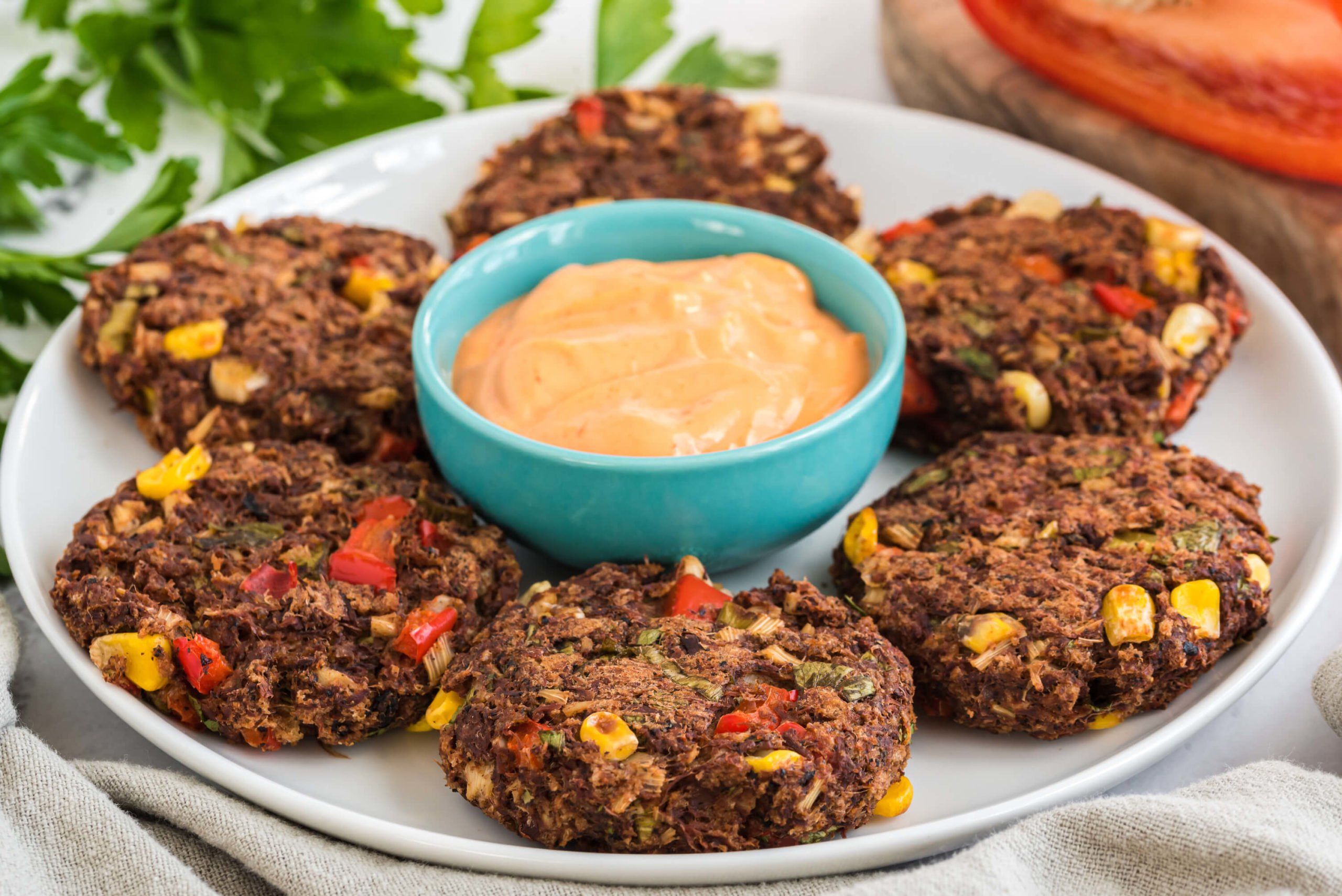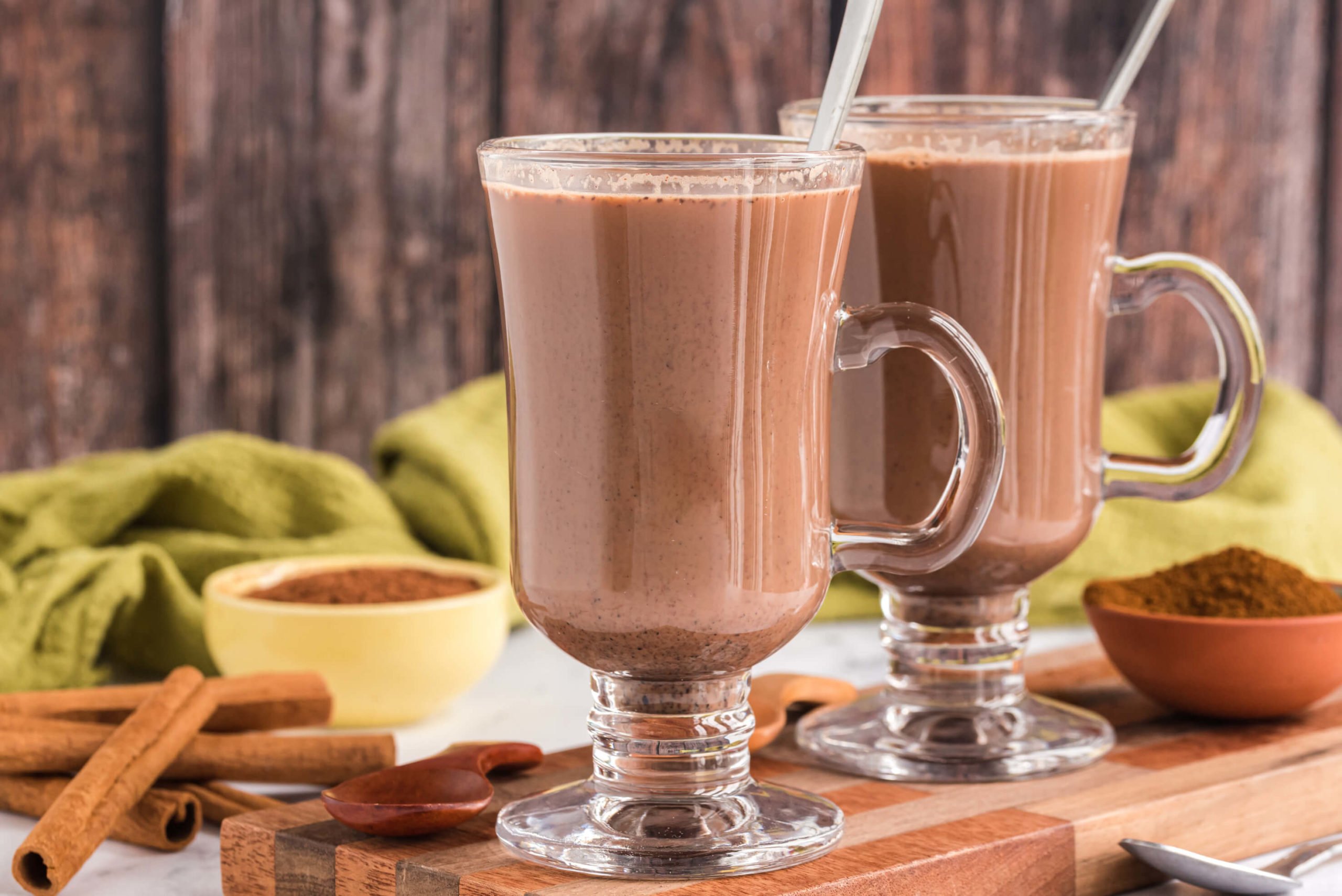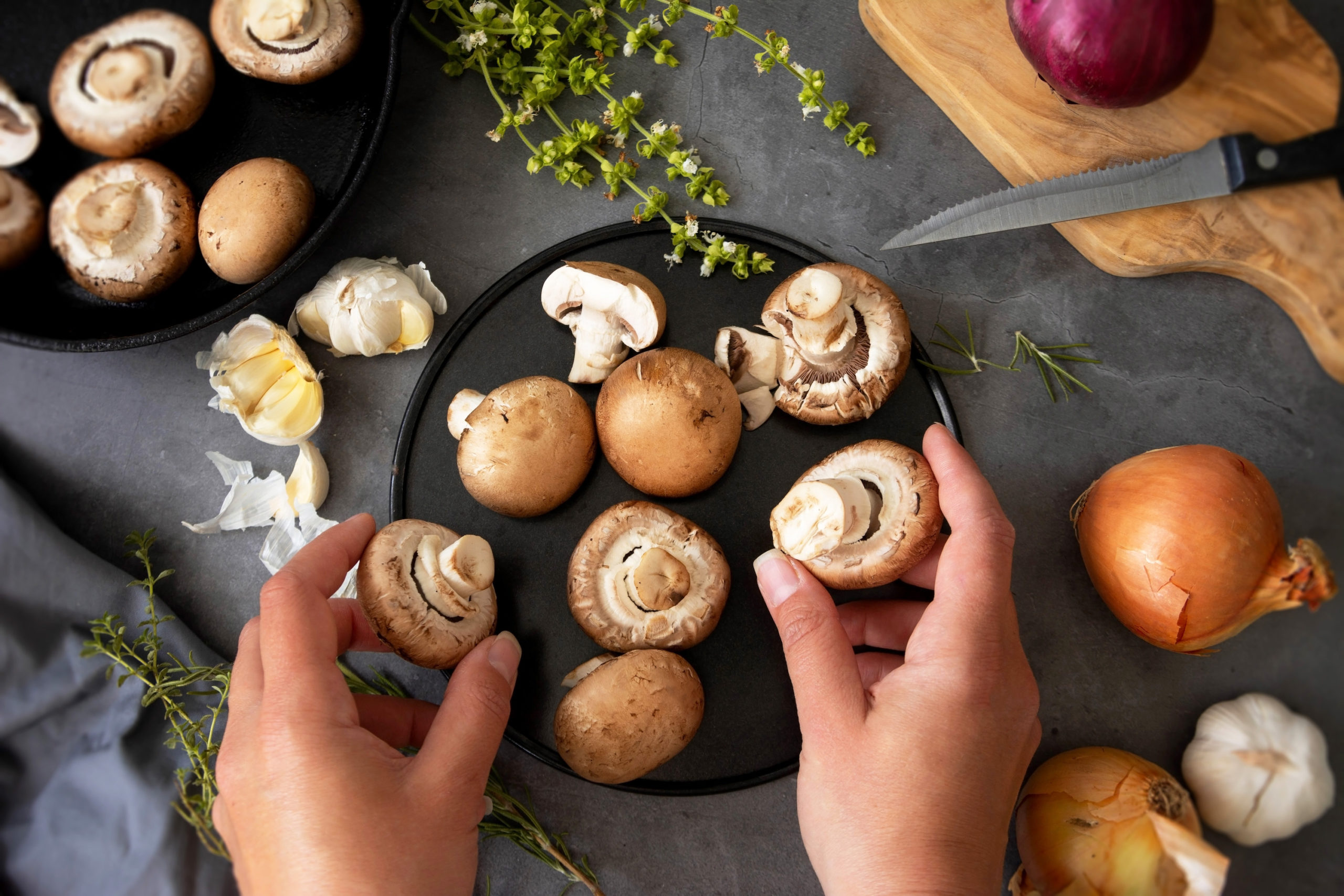White button mushrooms or juicy portobellos, both commonly found at grocery stores, might come to mind when you think of mushrooms. (Or, maybe your first thought was the Amanita muscaria mushroom that shows up as Super Mario’s classic red cap with white spots.) You might be surprised to learn that there’s a whole wide world of culinary fungi beyond what you see in the produce aisle.
Edible mushrooms have been a staple ingredient across cultures for thousands of years. The Romans considered mushrooms the “Food of the Gods,” while the ancient Greeks believed they provided strength for warriors heading into battle. The wide use of mushrooms throughout history is likely due to their appealing and diverse culinary attributes. Today, mushrooms are touted for their many health benefits and medicinal properties. They’re low in calories, have zero saturated fat, and are free from cholesterol — while providing several essential vitamins and minerals that are vital for health.
Interestingly, mushrooms are neither plant nor animal. They’re part of the fungi kingdom, home to other fungal species such as yeasts, mildews, and molds. However, mushrooms are still considered a vegetable for culinary purposes (probably because few people want to eat something associated with the likes of mildew and mold).
White and Brown Foods Have Health Benefits, Too!
Edible mushrooms often lack color, which results in them being an underrated plant-based food, but they’re surprisingly nutritious and satiating. With their meaty texture and nutrient density, mushrooms can keep you satisfied long after mealtime is over.
And, you can add an enormous variety of mushrooms to your culinary toolbox to create healthy and delicious plant-based mushroom recipes. With dozens of edible mushrooms to choose from — all with their own health benefits, unique flavors, and textures — mushrooms can become a standout ingredient in your weekly recipe rotation.
In this article, we’ll discuss how to prepare and cook mushrooms, including tips on how to use their unique umami flavor and texture to take healthy, mushroom-based meals to the next level. We’ll also give you seven delicious and nutritious plant-based mushroom recipes — not to mention the ones that we’re scattering throughout the article — to keep you satisfied and looking for more fungi in your life.
Why Are Mushrooms Healthy?
At first glance, mushrooms don’t look all that nutritious if you judge a fungus by its color. However, these tan and white beauties are actually nutritional powerhouses. Edible mushrooms are particularly rich in several B vitamins — B2, B3, B5, B6, and B12 — which are vital for metabolism, brain health, cellular function, and blood cell production, to name just a few of the roles they play in keeping you healthy. They’re also high in minerals such as selenium, copper, phosphorus, potassium, and iron while delivering other essential nutrients like carbohydrates, protein, fiber, and antioxidants that keep your body functioning at its best. Mushrooms have also been shown to help with depression and anxiety and support overall mental health, due to their nutritional properties.
Edible mushrooms are one of the few plant-based dietary sources of vitamin D. While mushrooms don’t inherently contain this mood-boosting nutrient critical for bone health, immune support, and muscle function, they can synthesize vitamin D when exposed to ultraviolet (UV) radiation from direct sunlight (just like humans!). In addition, eating healthy meals with mushrooms may lower your risk of developing several diseases that rank among the top causes of death in the US, including heart disease, Alzheimer’s disease, type 2 diabetes, and cancer. Several studies have found that mushrooms can improve cardiovascular health by reducing blood pressure, maintaining healthy cholesterol levels, and helping to treat iron-deficiency anemia.
The Best Mushrooms to Cook With

If you want to add more fabulous fungi to your menus, we have excellent news: Mother Nature has gifted us a bounty of tasty mushroom options. Each one provides its own unique flavor and texture that add variety and succulent satisfaction to your culinary creations. This likely explains why mushrooms have been a popular culinary staple across cultures for centuries and have become such tasty additions to many vegan dishes.
Some mushrooms offer sweet flavors, while others provide nutty, earthy flavors. Mushrooms like portobello make ideal meat substitutes because they have an appealing chewy, meaty texture that’s highly satisfying and enjoyable to eat. You can toss portobellos on the grill to make healthy plant-based burgers or steaks, or dice them to use in a stuffed vegetable recipe.
We’d be remiss if we didn’t discuss mushrooms’ unique umami flavor. Humans have four primary tastes — sweet, sour, salty, and bitter. However, some foods have a fifth primary taste called “umami,” and mushrooms are among the foods that offer this flavor. It’s best described as a mild, subtle, and lingering taste that spreads across your tongue. It adds a savory depth to recipes that can complete a dish. In fact, umami means “essence of deliciousness” in Japanese.
Some of the best culinary mushrooms to use in creating healthy mushroom recipes are:
- Button
- Chaga
- Chanterelle
- Cremini
- Enoki
- Lion’s mane
- Maitake
- Morel
- Oyster
- Porcini
- Portobello
- Reishi
- Shiitake
If you’re interested in how mushrooms can benefit your health, check out our article on The Power of Mushrooms: Nutrition, Benefits, & Risks of Edible Mushrooms.
How to Select and Store Your Mushrooms
Whether browsing the produce aisle or foraging in the forest, look for firm and smooth mushrooms without noticeable soft or blemish spots. Their surface should be dry (not dried out) and never moist or soggy since this means the mushroom has begun to decompose and could potentially make you sick. Important Note: If you’re new to foraging, always explore with an expert — it can be very easy to misidentify mushrooms, and we don’t want anyone to make what could be a life-threatening mistake.
Mushrooms have naturally high water content and soak up additional water quite easily. Therefore, washing them thoroughly in water before using, as we suggest for most fruits and vegetables, isn’t recommended. Simply wipe them with a pastry brush or clean kitchen towel to remove any dirt that remains after harvesting. If they’re extra dirty, you can rinse them just before using them in a recipe. Avoid rinsing before storing them, as they’ll turn mushy. Once they’re rinsed, dry them off with a towel.
As for storing your fungi, use a container that allows for good airflow to maximize air circulation, keeping the mushrooms fresh while not drying them out. Alternatively, you can wrap mushrooms in a paper towel and store them in an open brown paper bag in the fridge. They should last for four to seven days when stored properly in the refrigerator.
Can You Freeze Mushrooms?
Now, for the big question: Can you freeze mushrooms? Technically, yes. However, if they’re frozen from their fresh state, you run the risk of them turning mushy. The best way to freeze mushrooms is to cook them first (sautéing works well) to reduce their water content and concentrate their flavor before letting them cool and then transferring them to an airtight freezer-safe container. When you’re ready to use them in a recipe, simply add them directly to the recipe, allowing them to cook through. There’s no need to let them thaw first.
Mushroom Powders

Mushrooms do have a unique texture, unlike any other plant (which is one of the many reasons they’re so special!). However, their texture isn’t for everyone. Fortunately, you can still receive mushrooms’ myriad health benefits by consuming mushroom powders, elixirs, or coffees.
Various mushroom products contain medicinal mushrooms, such as lion’s mane, chaga, cordyceps, reishi, shiitake, and turkey tail. Adding mushroom powders to a smoothie or morning coffee can enhance antioxidant activity, support your immune system, aid blood sugar regulation, and boost brain health. However, mushroom powders come with a high price tag, deterring some people from buying them regularly.
The good news is you can create your own mushroom powders by dehydrating mushrooms and grinding them into powder form.
How to Cook and Use Mushrooms in Recipes
When adding mushrooms to recipes, cook them at a medium-high temperature to reduce their water content and prevent them from becoming soggy. Doing so will also concentrate the mushrooms’ flavor. Mushrooms can be cooked in various ways, but roasting them is an excellent option since the high, dry heat enhances their meaty, savory flavor. Additionally, sautéing mushrooms with a small amount of water, vegetable broth, or coconut aminos will bring out their umami flavor.
Mushrooms can inject a new dimension of flavor into many vegan recipes. For example, mushrooms such as chanterelles have a peppery taste, making them a perfect addition to avocado toast or a tofu scramble. Portobello mushrooms are another excellent example of flavor-enhancing mushrooms. Their chewy texture and meaty flavor make for delicious and healthy mushroom burgers or steaks that you can grill on the barbecue or roast in the oven. Another way to get more fungi onto your plate and into your belly is dicing up mushrooms and adding them to salads, soups, stews, tacos, or sandwiches to add a chewy texture and savory flavor. And if you’re still not persuaded to eat them, add a teaspoon or two of mushroom powder to coffee, tea, or warm water and enjoy the health benefits.
Healthy Plant-Based Mushroom Recipes
These wholesome plant-based mushroom recipes showcase fabulous fungi in all of their umami glory. From flavor-packed shiitakes to immune-supporting lion’s mane and many more mushrooms in between, you’ll get to experience the variety and uniqueness that each type has to offer. Mushrooms are incredibly versatile and can add excitement and adventure to your culinary experience and meals!
1. Breakfast Chanterelle Avocado Toast

It’s time to uplevel your everyday avocado toast with the umami flavor, antioxidant power, and fiber-filled goodness of delicious (and exotic!) chanterelle mushrooms. Chanterelles are delicate in flavor and are sometimes described as “mildly peppery,” making them a perfect complement to avocado toast for an oh-so-satisfying breakfast.
2. Lion’s Mane Cakes

Mushrooms make a wonderful substitute for seafood thanks to their umami-rich flavor and often flaky, meaty, and chewy textures — just like our friend lion’s mane! Large, white, and shaggy (and quite beautiful!), they really do resemble a lion’s mane as they grow. Research on them is promising, showing that lion’s mane can support brain health, immune function, blood sugar control, and mental wellness. Just think, you get all of these benefits in one plant-based swap! Enjoy Lion’s Mane Cakes as a distinctive appetizer to share among friends or a delicious “sammie” piled high with your favorite veggie toppings as a delicious weekday meal!
3. Air Fryer Stuffed Morels

These air-fried morel morsels are a game changer! Think stuffed cheesy jalapeños but with cashew-based cream cheese instead of dairy cheese, baked rather than fried, and umami mushrooms in place of spicy jalapeños. With such a creative way to use mushrooms, these wholesome little bites are going to become your new party go-to! Don’t own an air fryer? No problem! See the Chef’s Notes for baking them in the oven.
4. Wild Rice Mushroom and Baby Broccoli Salad

Gone are the days of a salad being thought of as not much more than lettuce in a bowl. This fulfilling and nourishing salad has all the ingredients to make your belly happy, taste buds sing, and body energized with the wild rice, umami mushrooms, and earthy broccoli. Tip: Make the rice and dressing ahead of time to save time on the day you plan to put the recipe together. Second tip: This healthy mushroom dish gets even tastier the next day!
5. Creamy Lemongrass Lime Shiitake Soup

Creamy Lemongrass Lime Shiitake Soup is a mushroom lover’s dream! Full of rich and robust flavors, this soup is a nourishing and aromatic treat for your tastebuds. To make this soup fully plant-based we’ve substituted shiitake mushrooms for traditional shrimp, giving every spoonful the perfect chewy and savory bite.
6. Italian Portobello Mushroom Bake

Thanks to their delectable aroma and tasty flavor, portobello mushrooms make the perfect meat replacement and have a ton of nutritional benefits. Have we mentioned that they’re a true culinary delight in the Italian Portobello Mushroom Bake? Individual portobellos are stuffed with cheesy, tomatoey goodness and baked until bubbly and golden. If you’re a fungi fan, then this vegan mushroom recipe is a quick, simple, and absolutely delicious way for you to enjoy mushrooms regularly!
7. Chaga Hot Cocoa

Once you taste this rich, creamy, and delicious mushroom beverage, it might be hard to believe it’s actually good for you. But it’s true! Chaga mushroom is chock-full of antioxidants and has been shown to reduce inflammation and support the immune system. Plus, it’s cozy, comforting, and has the perfect amount of natural sweetness, making it an ideal beverage as an anytime pick-me-up!
More Mouthwatering Mushrooms, Please!
Mushrooms are highly versatile, nutritious, and health-promoting foods, making them an excellent addition to many vegan recipes. You can explore a wide variety of mushrooms with their own unique textures and flavors. Try one or all of our delicious vegan mushroom recipes to discover the ones you love, then add them to your weekly meal rotation. And, if mushrooms still aren’t your thing, you can still reap their benefits with mushroom powders, elixirs, or coffee.
Tell us in the comments:
- Which of these healthy mushroom recipes will you try first?
- Are there other edible mushrooms you love that aren’t listed above?
- What are your favorite ways to cook mushrooms and use them in recipes?
Featured Image: iStock.com/Gingagi




